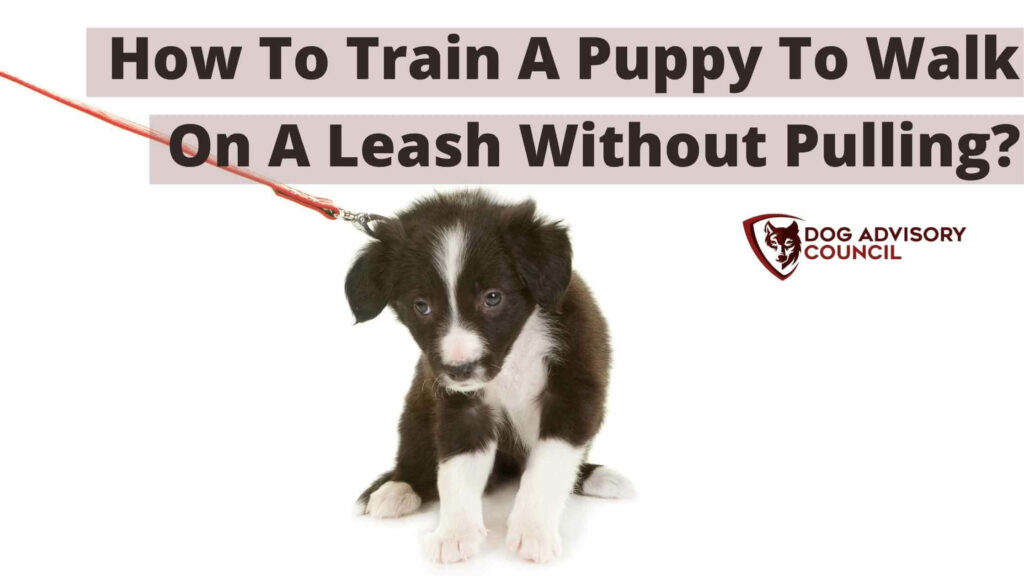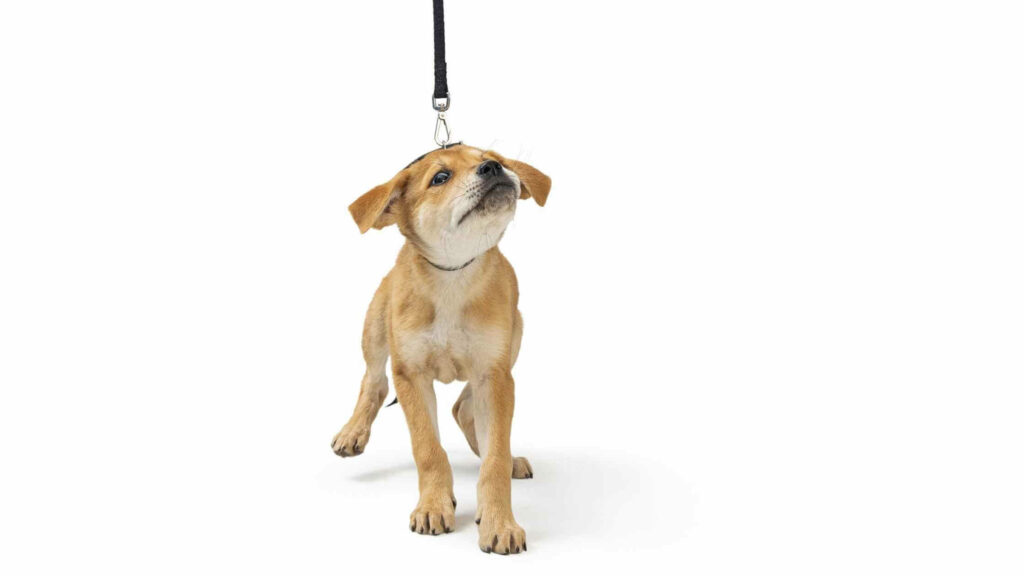
Is your puppy trying to rip your arm off every time you take them for a walk? If so, here’s how to train a puppy to walk on a leash without pulling!
The most common and effective way to train a puppy to stop pulling on their leash is to stop walking when they start to pull and only resume walking again when they come back to your side. It won’t be an instant lesson, but you can speed up the process by offering treats when they walk at your side consistently. Leash training is an important part of puppy training!
Why does my dog pull so hard on the leash?
Puppies and dogs pull on leashes because they fight the instinct of being trapped. In the wild, dogs would need to free themselves from branches and other things that trapped them. A leash feels like that for dogs, so they’ll fight the thing that holds them back.
The other thing is that dogs will fight the sensation of being held against their will. This is actually similar to humans. Think about it: what’s the first thing you do if someone grabs you without warning? Resist, exactly. So puppies and dogs are like that. They don’t understand what the leash is for, and they don’t understand why it is “trapping” them.
If you don’t leash train your puppy, they will continue to pull in their adult years, and this can lead to a difficult life with them as far as walking them successfully. Training them young is recommended when you want a focused life with proper leash skills!
How do I get my puppy to walk without pulling?
When learning how to walk a dog that pulls, you’ll want to focus on the following steps:
- Get the right leash and harness
- Walk slowly
- When puppy pulls, call their name
- Direct them to come back to you
- Stop walking and call them and command
- Repeat until they respond
- Treat to show the correct behavior
Get the right leash and harness
Since you’re leash training, you’ll want to have a comfortable leash and a harness. As far as the leash is concerned, go with a simple, durable one. Most recommend the nylon or paracord leashes.
You can also look at the bungee-style leashes if you want something with a bit of stretch in it. Don’t get a retractable leash until your puppy is trained correctly, even if you want to use one of them later.
Walk slowly
For the first few times you train your puppy, do it when there are minimal distractions, including listening to music or talking on the phone. Or roadway distractions such as other dogs and passing cars.
Keep your pace slow and pay attention to your dog’s motions. As soon as they start to pull on the leash, stop walking. This will set you up for the next step and ensure that your dog doesn’t hurt you or themselves as they lurch forward.
When puppy pulls, call their name
When your puppy starts to pull, call their name and give them the command that you’ve chosen for them to stop pulling and return to you. It’s essential to do it in this order because dogs will understand their name as a queue to pay attention. A command of sorts.
Direct them to come back to you
Whatever word that you choose for the command, you can accompany it with a motion to return to you if you want. It’ll be perfect for when you’re looking to make it a bit stronger and still stay consistent with what you need. Just make sure that you use that motion every time and that you use the same one!
Stop walking and call them and command
When you are looking at training your puppy to stop their leash pulling, you need to stop walking first, then call their name and then give the command. It’s essential to do it in this order and repeat this order every time that you need to do it. Again, consistency really matters here.
Repeat until they respond
You will need to do this multiple times, but you’ll want to also keep in mind that our puppy isn’t going to get it the first few times. This means you’ll need to convince them to come back to you even after you’ve given them the command. It’ll take some serious coaxing at first, and you’ll need to train them using treats.
Treat to show the correct behavior
The treat is important, of course. The treat helps them learn what to do to get the treat and then how not pulling gets them a treat. After they are comfortably trained, you can phase the treats out of it. Don’t do it too early, though, or it will hurt their progress!

How long does it take to train a dog to walk on a leash without pulling?
There’s no set amount of time, but you can expect it to take about 3-5 training sessions at the least. Some dogs are easier to train than others, so you’ll need to be consistent and focused on training this new skill as quickly as possible!
At what age should I start leash training my puppy?
If you want the best results when looking at leash training your puppy, you’ll want to focus on starting the process as soon as you get them home. Most will be when their puppy is about 8 weeks old. You can train them when they are older, though, so don’t fear if you are bringing home an older puppy or an adult dog with bad leash habits!
Is a harness or collar better for a puppy who pulls?
Professionals will recommend a harness whenever you are doing any kind of leash training. It offers you better control over your puppy, firstly, and it will also reduce the chance of injury since a collar can put a lot of pressure on their neck as they’re learning not to pull on the collar.
You can switch between a harness and a collar as they start to adjust to leash training if you want. They’ll be more likely to notice the difference in the pressure if you do this. Many will use this approach once their puppy is comfortable walking without pulling. Occasionally, this can cause some regression a bit, but it’s only temporary.
Don’t switch permanently to collar-based leash walking until you are sure your puppy is responding properly to the command to stop them from pulling. This is just to ensure that you minimize any kind of health risk!
Will a harness stop a dog from pulling?
A harness isn’t, in itself, going to stop your dog from pulling. However, you’ll find that they’ll respond better with a harness, and it helps you maintain better control over them, as we mentioned above.
Some pet parents prefer to stick with a harness permanently, and that’s a great idea to always ensure that you can control your puppy and dog as best as possible!
How do I stop leash pulling in 5 minutes?
While it’s certainly a nice thought, the reality is that you won’t be able to permanently stop your dog from pulling after a sheer 5 minutes of leash training. However, you can help them remember their previous lesson (or lessons) in 5 minutes.
To do this, you’ll repeat the steps we highlighted above, and depending on your dog’s obedience, this will remind them about the proper way to walk.
Remember, too, that a dog’s learned behavior to walk at your side is just that — a learned behavior. Their natural instinct will always be to tug and pull against whatever restrains them.
To overcome this powerful instinct, you’ll need to be consistent and persistent with your chosen training! Make sure that everyone who walks your dog is consistent, too, for the best results.
How to train a dog to walk on a leash beside you
If you’re looking for a way to get your puppy or dog to walk beside you, you’ll be glad to know that it’s going to be as simple as taking the steps above and just retraining your dog to heel next to you.
This is a good habit to get into anyway, since you’ll want to ensure that your dog matches your pace and, of course, doesn’t pull on the leash! Most pet parents find that walking with their dog at their side is a much more enjoyable experience.
Keeping your puppy from pulling on their leash is a matter of training them on what behavior is appropriate and what behavior isn’t. You can train your puppy to walk properly, just like any other behavior you want to retrain.
All things considered
When you’re looking for a way to help your puppy learn how to keep from pulling on their leash as they walk, the best approach is to stop walking when they start to pull and reward them with a treat when they come back to sit at your side. You can also treat them if they walk at your side rather than charging ahead.
